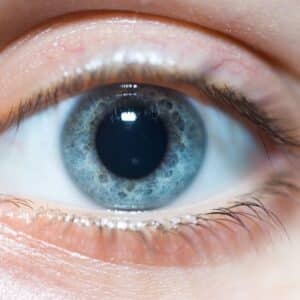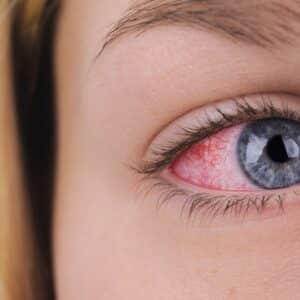What is Age-Related Macular Degeneration?
Age-Related Macular Degeneration (AMD) is a progressive eye disease that affects the macula, a small area in the retina responsible for central vision. It is the leading cause of vision loss among people over 50. AMD occurs in two forms: dry AMD, the most common form, and wet AMD, which is less common but more severe.
In dry AMD, small yellow deposits called drusen form under the macula, causing it to thin and deteriorate over time. This leads to a gradual loss of central vision, which is essential for reading, driving, and recognizing faces. There is no cure for dry AMD, but lifestyle changes such as eating a healthy diet, exercising regularly, and not smoking can help slow its progression.
Wet AMD occurs when abnormal blood vessels grow under the macula and leak blood and fluid, causing rapid and severe vision loss. Treatment for wet AMD includes injecting drugs directly into the eye to stop the growth of abnormal blood vessels and prevent further vision loss.
Regular eye exams are essential for detecting AMD early and managing its progression. If you are over 50 or have a family history of AMD, it is important to schedule regular eye exams with your eye doctor to monitor your eye health.
Symptoms of Age-Related Macular Degeneration
Age-Related Macular Degeneration (AMD) often develops slowly and painlessly, with no noticeable symptoms in the early stages. As the disease progresses, the following symptoms may appear:
- Blurred or distorted vision: Straight lines may appear wavy, and objects may appear smaller or farther away than they are.
- Reduced central vision: The ability to see details, colors and contrasts may be affected, making it difficult to read, drive, or recognize faces.
- Dark or empty areas in vision: A blind spot or dark area may appear in the center of the visual field.
- Difficulty adjusting to low light levels: It may take longer for the eyes to adjust from a brightly lit area to a dimly lit one.
- Changes in color perception: Colors may appear less vibrant or faded.
- Need for brighter light when reading or doing close work: The eyes may require more light to focus on close-up tasks.
It is important to note that other eye conditions may also cause these symptoms, so seeing an eye specialist for a comprehensive eye exam is essential if you experience any vision changes.
Causes of Age-Related Macular Degeneration
The exact causes of Age-Related Macular Degeneration are not fully understood. However, researchers have identified several risk factors that can contribute to the development of the disease. These include:
- Age: AMD is most commonly diagnosed in people over 50.
- Genetics: A family history of AMD increases the risk of developing the disease.
- Smoking: Smoking can significantly increase the risk of developing AMD.
- Obesity: Obesity has been linked to an increased risk of developing AMD, making weight control a crucial preventative measure.
- Cardiovascular disease: High blood pressure, high cholesterol, and other cardiovascular risk factors may contribute to the development of AMD.
- Sunlight exposure: Long-term exposure to ultraviolet (UV) light from the sun may contribute to the development of AMD.
- Nutritional factors: A diet low in fruits and vegetables and high in saturated fats may increase the risk of AMD.
It is important to note that having one or more of these risk factors does not necessarily mean that a person will develop AMD, but it is essential to manage these risk factors through lifestyle changes and regular eye exams.
Diagnosis of Age-Related Macular Degeneration.
Age-Related Macular Degeneration (AMD) is diagnosed through a comprehensive eye exam, which includes several tests to evaluate the health of the retina and the macula. The following tests are commonly used to diagnose AMD:
- Visual acuity test: This test measures the clarity of vision at a distance using an eye chart.
- Dilated eye exam: During this exam, eye drops dilate the pupils, allowing the eye doctor to examine the retina and macula.
- Amsler grid test: This test uses a grid pattern to check for distortion or changes in central vision.
- Optical coherence tomography (OCT): This non-invasive imaging test uses light waves to create a detailed image of the retina and macula, allowing the eye doctor to detect any abnormalities.
- Fluorescein angiography: This test involves injecting a dye into a vein in the arm, which travels to the eye and highlights the blood vessels in the retina. Photographs are then taken to evaluate any abnormal blood vessels.
- Indocyanine green angiography: Similar to fluorescein angiography, this test involves injecting a dye into a vein in the arm to evaluate the blood vessels in the choroid, which is the layer of blood vessels beneath the retina.
Once a diagnosis of AMD is made, the eye doctor can determine the type and severity of the disease and recommend a treatment plan to manage its progression. Regular eye exams are essential for monitoring the health of the retina and macula and detecting any changes early.
Treatment of Age-Related Macular Degeneration
The treatment of Age-Related Macular Degeneration (AMD) depends on the type and severity of the disease. Dry AMD has no cure, but specific lifestyle changes and treatments may help slow its progression. The following are some common treatments for AMD:
- Nutritional supplements: Certain vitamins and minerals, including vitamin C, vitamin E, zinc, and copper, may help reduce the risk of advanced dry AMD.
- Anti-VEGF injections: For wet AMD, medications called anti-VEGF drugs are often used to stop the growth of abnormal blood vessels and prevent further vision loss.
- Laser therapy: In some cases, laser therapy may destroy abnormal blood vessels and prevent them from leaking fluid.
- Photodynamic therapy: This treatment involves injecting a drug into a vein in the arm, which travels to the blood vessels in the eye. A laser then activates the drug and destroys the abnormal blood vessels.
- Low vision aids: For people with advanced AMD, low vision aids such as magnifying glasses, special lenses, and electronic devices may help improve vision and enhance the quality of life.
Early detection and treatment are essential for managing the progression of AMD and preventing further vision loss. Regular eye exams are essential for monitoring the health of the retina and macula and detecting any changes early.
Preventing the Progression of AMD
While there is no surefire way to prevent Age-Related Macular Degeneration (AMD), specific lifestyle changes can help limit the risk factors associated with the disease and slow its progression. Here are some habits that may help reduce the risk of developing or slow the progression of AMD:
- Quit smoking: Smoking has been known to increase the risk of developing AMD and cause it to progress more rapidly. Therefore, eliminating smoking can help reduce the chances of developing this eye disease and slow its progression.
- Maintaining a healthy weight: Achieving and maintaining a healthy weight is essential in reducing the risk of Age-Related Macular Degeneration (AMD), as obesity and other factors associated with unhealthy lifestyles are linked to this eye condition.
- Eat a healthy diet: Eating a healthy diet may help protect against AMD. Nutrients found in fruits, vegetables, and omega-3 fatty acids are especially beneficial for people with the condition. On the other hand, foods rich in saturated fats, processed foods, and sugary beverages should be avoided.
- Protect your eyes from sunlight: Long-term exposure to ultraviolet (UV) light from the sun may contribute to the development of AMD. Wearing sunglasses with UV protection and a wide-brimmed hat may help protect the eyes from harmful UV rays.
- Control blood pressure and cholesterol levels: High blood pressure and cholesterol levels may contribute to the development of AMD. Managing these conditions through medication, diet, and exercise may help reduce the risk.
- Get regular eye exams: Regular eye exams are essential for monitoring the health of the retina and macula and detecting any changes early. People over 50 or with a family history of AMD should have a comprehensive eye exam every one to two years.
By adopting these healthy habits, individuals can reduce their risk of developing AMD and slow its progression if it does occur.
Facts About Age-Related Macular Degeneration
Here are some facts about Age-Related Macular Degeneration (AMD):
- AMD is an eye condition that affects older adults, and it is the leading cause of vision loss in developed countries for people over 50.
- There are two types of AMD: dry and wet. Wet AMD is less common but more severe and can cause rapid vision loss.
- The risk of developing AMD increases with age, with most cases occurring in people over 60 years old.
- AMD is more common in women than in men.
- AMD is an eye condition associated with smoking. Quitting smoking can decrease the odds of getting AMD and possibly slow its progression.
- AMD is a complex disease that involves multiple genetic and environmental factors.
- Treatment for AMD depends on the type and severity of the disease and may include nutritional supplements, anti-VEGF injections, laser therapy, photodynamic therapy, and low-vision aids.
- Lifestyle changes such as a healthy diet, regular exercise, and protecting the eyes from sunlight may help reduce the risk of developing AMD or slow its progression if it does occur.
- Early detection and treatment are essential for managing the progression of AMD and preventing further vision loss.
- There is no cure for AMD, but research is ongoing to understand the disease better and develop new treatments.
Conclusion
Age-Related Macular Degeneration (AMD) is a common eye disease affecting millions worldwide. The disease causes damage to the macula, which is responsible for central vision, and can lead to severe vision loss over time.
While there is no cure for AMD, specific treatments and lifestyle changes can help slow its progression and improve quality of life. Regular eye exams, a healthy diet, quitting smoking, and protecting the eyes from sunlight are some habits that can help reduce the risk of developing AMD or slow its progression if it does occur.
By adopting these habits and seeking timely medical attention, individuals can take control of their eye health and manage the impact of AMD on their vision.






